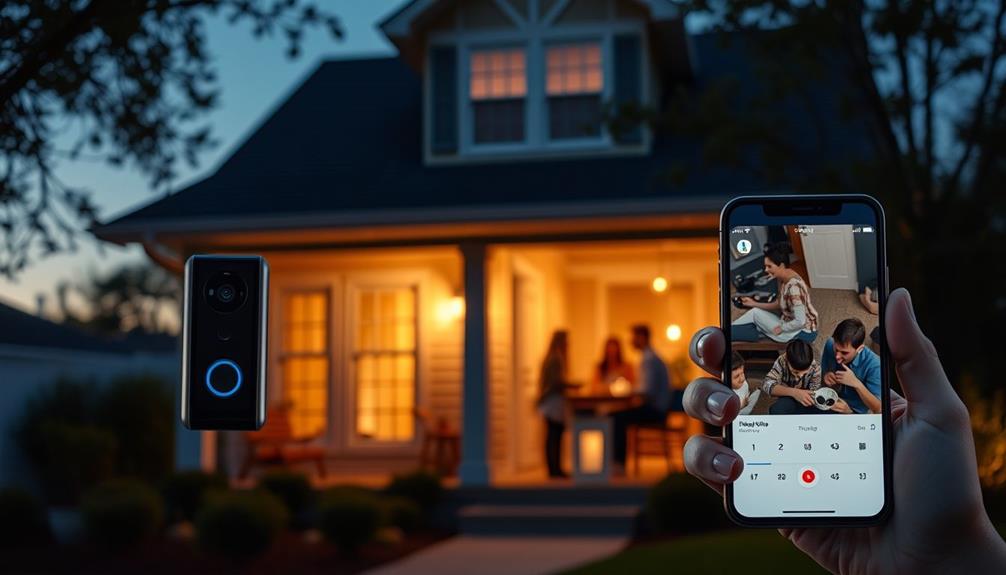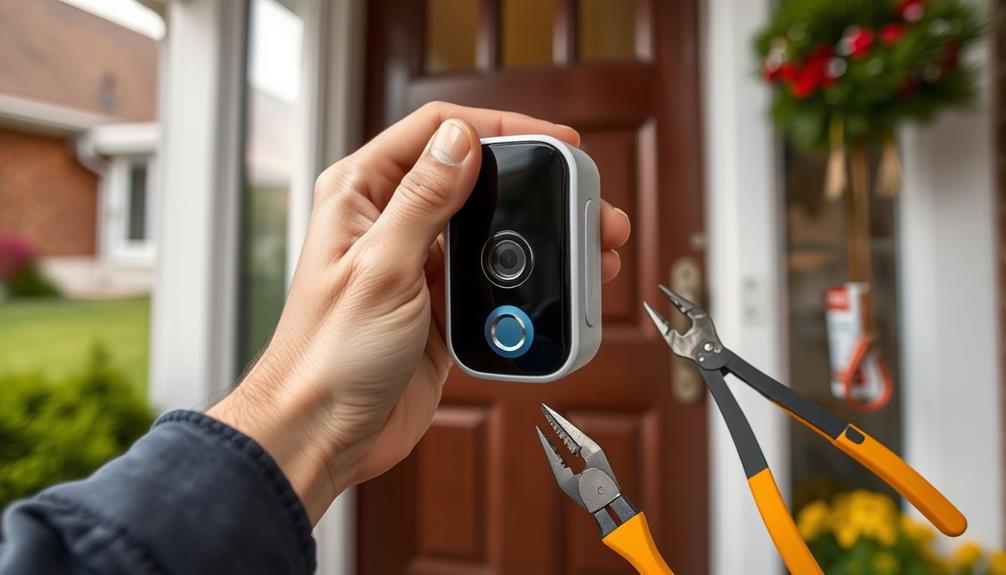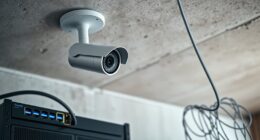To improve performance on your Ring Doorbell, begin by ensuring a strong Wi-Fi connection with an RSSI below 60. Consider relocating your router closer to the doorbell or using extenders for better coverage. It is also recommended to clean the device and inspect the wiring for any damage. Make sure to restart the Ring app and check for updates as well. If the issues persist, you may want to reach out to the Ring Community for advice or consider seeking professional help to evaluate your setup. By addressing these factors, you can significantly boost performance and explore other strategies to ensure your device operates smoothly.
Key Takeaways
- Ensure a strong Wi-Fi connection with an RSSI value below 60 for optimal performance of the Ring Doorbell.
- Relocate the router closer to the doorbell to reduce signal interference and improve connectivity.
- Use a 2.4 GHz band for better range, especially for devices located farther from the router.
- Regularly clean the doorbell and camera lenses to remove dirt that may obstruct performance.
Identify Common Lag Issues
Many users experience common lag issues with their Ring Doorbells, often noticing delayed notifications and sluggish video streaming. These lag issues can manifest as notifications arriving 10-15 seconds after someone presses the doorbell, which can lead to missed interactions with visitors.
If you find yourself waiting for alerts that seem to take an eternity, it's likely linked to your WiFi signal strength. Additionally, having a clean indoor environment can support better device performance, much like how air purifiers improve indoor air quality by reducing allergens and pollutants.
When your WiFi signal is weak, specifically with RSSI values between 59 and 65, the performance of your Ring Doorbell can suffer. You might also experience delayed motion detection, where alerts arrive several minutes late, despite having a fast internet connection.
Environmental factors can worsen these issues. For example, interference from other electronic devices or being too far from the router can impact your doorbell's responsiveness.
To tackle these lag issues, keep an eye on your WiFi signal's strength and consider your surroundings. In some cases, adjusting your WiFi settings, such as changing channels or utilizing extenders, can help resolve these frustrating delays and improve the overall performance of your Ring Doorbell.
Check Wi-Fi Connectivity

To guarantee your Ring Doorbell functions smoothly, check that it's connected to a strong Wi-Fi signal with an RSSI of 50 or lower. This is crucial, as a solid Wi-Fi connection can greatly enhance the user experience and prevent interruptions, much like how travel experiences impart unforgettable life wisdom.
Poor signal strength can lead to lag and connectivity issues. Here are some steps you can take to enhance your doorbell's performance:
- Relocate your router: If possible, move your Wi-Fi router closer to the doorbell to boost signal strength.
- Minimize interference: Keep electronic devices that might cause interference away from your router and doorbell.
Regularly monitor your internet connection, as fluctuations can greatly impact how your Ring Doorbell operates. An unstable internet connection can result in delays or missed notifications, so it's vital to confirm everything is running smoothly.
Troubleshoot App Performance

After ensuring your Ring Doorbell has a strong Wi-Fi connection, it's important to address any performance issues with the Ring app itself. If you're experiencing frequent freezing during video playback, consider uninstalling and reinstalling the app. This action can clear any potential corruption in the app's data, improving performance.
Additionally, ethical considerations in AI highlight the significance of user privacy in smart home devices, which may also affect your app experience.
If you're lagging or noticing unresponsiveness after viewing multiple videos, try restarting your device. This simple step refreshes your system and app memory, often resolving these issues.
Additionally, check the RSSI (Received Signal Strength Indicator) on the Device Health screen within the Ring app. A poor RSSI can indicate connectivity problems that may be impacting app performance.
Make sure your Ring app is updated to the latest version, as updates often include essential bug fixes and performance improvements. It's worth noting that many users report performance issues following iOS updates, suggesting a potential link between app stability and your device's operating system.
Keeping your app updated can help mitigate these problems. By following these steps, you can enhance the overall performance of your Ring app and enjoy smoother functionality.
Inspect Hardware Connections

Inspecting your Ring Doorbell's hardware connections is vital for preventing lag and guaranteeing ideal performance. Start by checking the wiring connections to confirm they're secure and undamaged. Loose or corroded connections can lead to performance issues, so take the time to inspect them closely. Additionally, making sure that your home is clean and free of obstructions can contribute to better device performance, as outlined in key factors in choosing a home cleaning service.
Here are key areas to focus on:
- Transformer Functionality: Verify the transformer outputs the correct voltage, typically between 16-24 volts. This is essential for reliable operation.
- Physical Damage: Look for any wear or damage at connection points. Damaged connections can disrupt power flow, leading to lag.
Additionally, regularly clean the doorbell and camera lenses to eliminate any dirt or obstructions that could affect responsiveness. By inspecting these hardware connections, you can greatly enhance your Ring Doorbell's performance and reduce lag, making sure it functions at its best when you need it most.
Adjust Network Settings

To improve your Ring Doorbell's performance, you need to adjust some network settings.
Start by checking the signal strength and optimizing your Wi-Fi channel to minimize interference, which is essential for maintaining a secure connection.
If you're still experiencing lag, consider using network extenders to boost the connection in weak areas.
Additionally, being aware of the importance of cybersecurity can help you implement necessary measures to protect your devices.
Optimize Wi-Fi Channel
Optimizing your Wi-Fi channel can greatly enhance your Ring Doorbell's performance by minimizing interference from neighboring networks. To achieve this, you'll need to access your router settings and switch to a less congested Wi-Fi channel.
Utilizing effective social media marketing strategies can also improve your overall connectivity experience as you become more aware of potential external factors. Using a Wi-Fi analyzer app can help identify the best channel for your network. Here are a few tips to guide you:
- Select channels 1, 6, or 11 for 2.4 GHz networks, as they're typically less crowded.
- Broadcast on the 2.4 GHz band instead of 5 GHz, since this frequency works better over longer distances and penetrates walls more effectively.
Regularly monitoring the RSSI (Received Signal Strength Indicator) in the Ring app is also essential. Aim for a value of -60 dBm or better to guarantee strong connectivity.
If your signal strength remains weak, consider relocating your router closer to the Ring Doorbell or installing a Wi-Fi extender. By optimizing your Wi-Fi channel, you can greatly reduce lag and improve your doorbell's performance.
Check Signal Strength
Checking the signal strength of your Ring Doorbell is vital for identifying connectivity issues that could be causing lag. To do this, open the Ring app and navigate to the Device Health page. Here, you'll find the Received Signal Strength Indicator (RSSI) value. An RSSI below 50 indicates poor signal strength, which can lead to considerable lag in notifications and performance. Aim for an RSSI of 60 or higher for ideal functionality.
If your signal strength is lacking, consider adjusting your Wi-Fi settings. Using the 2.4 GHz band is often more effective for devices further from the router, as it provides better range than the 5 GHz band. Additionally, if you notice interference from other devices, tweaking your Wi-Fi channel settings can help improve the signal strength.
Regularly monitoring the Device Health in the Ring app and troubleshooting your network settings will enhance overall connectivity. Don't forget to check the placement of your router, as its location can greatly impact signal strength. By taking these steps, you can minimize lag and make certain your Ring Doorbell performs reliably.
Use Network Extenders
Using network extenders can greatly boost your Ring Doorbell's Wi-Fi coverage, helping to minimize lag and improve performance. By enhancing signal strength, you can guarantee your doorbell functions effectively, no matter where it's installed in your home.
Here are a few tips to optimize your setup:
- Placement Matters: Position your network extenders within a reasonable distance from your Ring Doorbell to maintain a strong connection and avoid weak signal areas.
- Choose the Right Band: Connect your Ring Doorbell to the 2.4 GHz band. This band offers better range, especially in larger homes with obstacles, compared to the 5 GHz band.
Monitor Device Health

To guarantee your Ring Doorbell operates smoothly, regularly monitor its device health through the Ring app. Navigate to the Device Health section, where you'll find the Received Signal Strength Indicator (RSSI) value. Ideally, this value should be below 60 for best performance. A higher RSSI indicates a weaker Wi-Fi connection, so aim for an RSSI of 48 or lower to reduce lag and improve notification speed.
Check the Wi-Fi connection status to confirm your Ring Doorbell is connected to the appropriate 2.4 GHz band, which usually offers better range compared to 5 GHz. The Device Health page also shows the battery status (if applicable) and the firmware version, helping you keep your device updated for peak performance.
If you notice poor connectivity metrics, consider repositioning your router or adding Wi-Fi extenders to enhance signal strength.
Seek Community Support

Engaging with the Ring Community can provide valuable insights and solutions to help address lag issues with your Ring Doorbell. By creating a Ring account to post, you can join in the discussion and benefit from the shared experiences of other users facing similar problems. You'll likely find that many members have dealt with lag and discovered effective fixes.
Here are a few reasons why participating in the community is beneficial:
- Collective Knowledge: Tap into a wealth of tips and techniques shared by experienced users.
- Real-Time Updates: Stay informed about firmware updates that could enhance your device's performance.
Don't hesitate to ask questions and share your own experiences. You might be surprised at how quickly you can find an answer to your specific issue.
The community thrives on collaboration, and your input could help others too. So, log in, engage with fellow users, and take the next step toward a lag-free Ring Doorbell experience!
Consider Professional Assistance

If your attempts to fix lag on your Ring Doorbell haven't panned out, it might be time to call in a professional for help. Consulting an expert can provide you with tailored solutions that address your specific setup. By troubleshooting ring doorbell delay, a professional can also identify any underlying issues that may be causing the lag and implement the necessary fixes. Additionally, they can offer advice on optimizing your network and device settings to improve overall performance. With their expertise, you can enjoy a seamless and reliable experience with your Ring Doorbell.
Professionals can assess both the hardware and wiring to identify any potential damage or malfunction that could be contributing to the performance lags you're experiencing.
Moreover, they'll conduct a thorough evaluation of your Wi-Fi network. Sometimes, the signal strength or interference is the primary culprit behind those frustrating delays. By pinpointing the issues, professionals can recommend effective solutions, such as upgrading your router or adding extenders to enhance connectivity.
Engaging a professional can also lead to specialized support for your smart home devices, ensuring that your Ring Doorbell operates efficiently within your home's network environment. This means you won't have to deal with lag issues any longer.
Frequently Asked Questions
Why Does My Ring Doorbell Lag so Much?
Your Ring Doorbell might lag due to a weak Wi-Fi signal. If the RSSI is below 60, you're likely facing connectivity issues.
Even with high-speed internet, delays can happen because of internal latency between devices. Environmental factors, like interference from other electronics, can also impact performance.
Moving your Wi-Fi router closer to the doorbell or using extenders could help. Regularly updating your firmware is essential to avoid performance lags too.
Why Is My Ring Doorbell Choppy?
So, you've got a Ring Doorbell that's more choppy than a bad sitcom?
Well, it might be suffering from a weak Wi-Fi signal—think of it as your doorbell's version of stage fright.
If it's got an RSSI value below 60, you're in trouble.
Interference from other gadgets can add to the chaos, too.
Try moving your router closer or using a Wi-Fi extender to give your doorbell a much-needed boost!
How to Improve Signal Strength on Ring Doorbell?
To improve the signal strength on your Ring Doorbell, start by checking the RSSI in the Ring app. If it's below 60, consider connecting to the 2.4 GHz Wi-Fi band for better range.
Move your router closer to the doorbell or use Wi-Fi extenders to enhance coverage.
Also, inspect for interference from devices like microwaves.
Why Does My Ring Doorbell Keep Buffering?
Did you know that over 70% of buffering issues with smart devices stem from weak Wi-Fi signals?
If your Ring Doorbell keeps buffering, it's likely due to poor connectivity.
Check your Wi-Fi signal strength; an RSSI below 60 can cause delays.
Other devices on your network might be causing congestion, too.
Regularly monitor your device health in the Ring app for insights on connectivity and potential issues affecting performance.
Conclusion
So, after all that fuss about fixing lag on your Ring Doorbell, you might just find that the real culprit was your Wi-Fi speed—who knew?
It's almost poetic how a tiny device can hold your home security hostage.
But hey, once you've tackled those pesky issues, you'll be rewarded with smooth performance, and you can finally enjoy those live feeds without feeling like you're watching a slow-motion movie.
Isn't technology just delightful?









